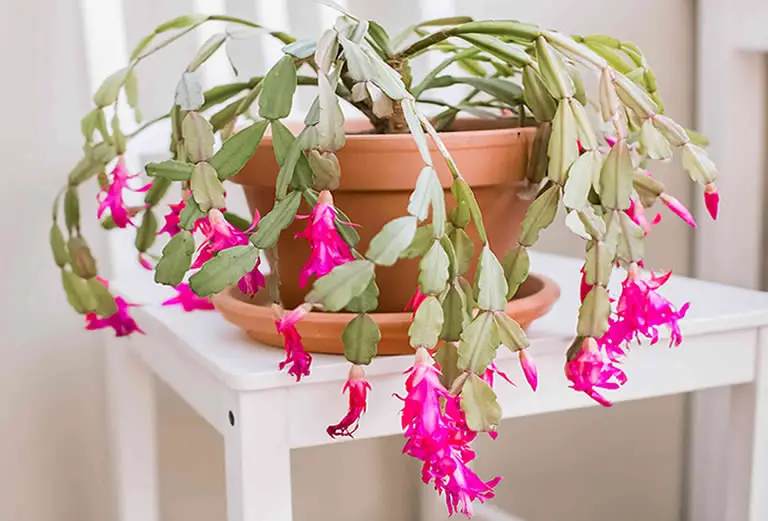Christmas cactus is a very common houseplant in the US and part of the holiday cacti range. It is the beautiful late December bloom that gives this plant its name. Although this type of cacti is considered an easy-care plant it does have seven essential care needs that you must get right if you want to cultivate a healthy, long-living plant that produces colorful flowers every year.
Here I outlined each of the essential 8 care needs along with easy-to-apply steps for ensuring you cover each one correctly. All holiday cacti require similar care.
Table of Contents
The 8 BASIC CARE NEEDS OF THE CHRISTMAS & HOLIDAY CACTUS
Christmas cactus is a tropical perennial succulent that grows natively in the coastal areas of south-east Brazil.
As a tropical plant it has some very specific environmental requirements and because it grows naturally in warm tropical regions it is only really suitable as an indoor plant in most parts of the US.
The christmas cactus, scientific name Schlumbergera bridgessii, is a member of the broader succulent family Schlumbergera.
Other species of this succulent family include the thanksgiving cactus, crab cactus and the easter cactus. Many people misidentify all of these plant species as christmas cactus.
Collectively these plants are referred to as holiday cacti or holiday cactus. You may have a one of the other holiday cacti mistakenly believing it to be christmas cactus.
Luckily though, as far as care routine goes, this is not a problem.
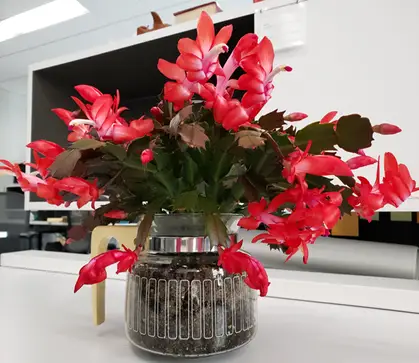
All holiday cacti plants require the same care routine.
So, regardless of whether you have a christmas cactus or one of the other popular holiday cacti this guide will give you the 8 essential care steps you need to take to grow a healthy plant.
The 8 essential care needs of a christmas cactus (and all holiday cacti) are:
- The correct soil.
- The correct pot.
- Adequate temperature range.
- Higher than normal humidity.
- The correct light at correct intervals.
- A proper watering routine (the most important thing to get right).
- The correct fertilizer.
- The correct feeding schedule.
Get the above 8 essential care points correct from the first time you bring this beautiful succulent into your home and you will have to attend to your christmas cactus much less than you do your other houseplants. Correct care means you will see your christmas cactus bloom year on year and your plant can live for many decades (up to 100 years).
However, if you get any of the 8 essential care needs wrong your plant will like develop foliage problems that can range from the minor to the very serious (see our article about christmas cactus leaves for potential foliage problems and their solutions.)
Christmas Cactus Soil & Pot Guide
The first thing you must get right when caring for christmas cactus is the growing medium used to cultivate the plant.
The growing medium of a plant usually refers to only the soil in which the plant is growing. However, with many types of succulents the growing medium refers to both the soil and the pot that houses the plant.
So, the first two things you must consider when caring for christmas cactus is the soil and the pot used for the plant.
1. You can use a standard cactus soil for christmas cactus
Christmas cactus is a tropical succulent and therefore requires a special type of soil to grow.
The soil you use for christmas cactus must have enough nutritional content to help the plant grow in a healthy manner but that does not have so much nutritional content that it over-feeds the succulent. This is why regular potting mix, or compost, is much too rich for christmas cactus.
In addition, normal houseplant soil is much too dense for succulents and will hold on to water for longer than is healthy for the plant.
It is therefore essential you use a soil that drains away excess water quickly and effectively.
A good quality succulent soil will suffice for christmas cactus.
Just be sure the soil you choose has a good mix of sand, perlite and compost at a ratio of 1:3, i.e. one third sand, one third perlite (or vermiculite) and one third compost or potting mix.
The above mix means the plant will not be given given too much nutrients and thus be overfed, while it also ensures fast and effective water drainage which is essential for christmas cactus as the plant will develop serious problems if it sits for long periods in moisture-heavy soil.
We have an article dedicated to christmas cactus soil that you can read to get a deeper understanding of the soil requirements of this succulent. The article also shows you how to mix your own soil for optimum christmas cactus growth.
2. It is essential you use a pot that has good drainage & encourages higher humidity (yes the pot can do that)
Whatever pot you choose for your christmas cactus it must have a sufficient number of holes at the bottom to ensure good water drainage.
Many pots will have just one large hole located at the center of the bottom of the pot and this is perfectly fine.
Christmas cactus should never be potted in a container that has no drainage holes.
Succulents do not like to sit in water nor do they like to sit in water-drenched soil.
Therefore your christmas cactus pot must have adequate drainage capability. For this reason you will see many christmas cactus houseplants in terracotta pots with trays underneath them.
Terracotta pots are by far the best christmas cactus pots for several reasons.
Why terracotta?
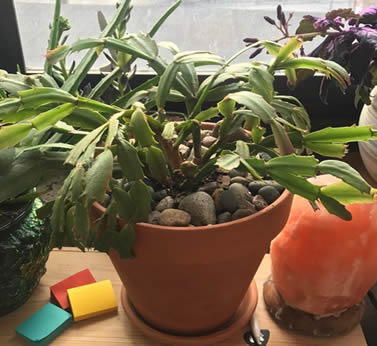
Well, although all succulents require a good draining pot to ensure there is very little water retention in the soil, terracotta is by far the best because it has the unique ability to “sweat” away moisture from the soil to the outside of the pot.
The water in the soil slowly seeps through the material further ensuring the roots of the plant do not sit in water-heavy soil.
But there is a secondary benefit of this moisture sweating that terracotta provides.
Christmas cactus, like all holiday cacti, requires higher levels of humidity than most other plants including some other succulents.
A terracotta pot can help provide that higher humidity in the localized environment directly around the plant.
Through s simple mechanism known as “sweating” the pot wicks away soil moisture through it pours to the outside of the pot.
These tiny water droplets then evaporate, creating humidity directly around the plant.
This sweating effect reduces the need to use a grow light (under normal conditions) and eliminates the need to increase the overall humidity of the room in which the plant is located.
How can a terracotta pot help improve humidity around a plant?
This is why I always advise houseplant owners with humidity-loving plants to use terracotta.
If you want more information on how this works read our guide what kind of pots do christmas cactus like.
Christmas Cactus Temperature & Humidity Needs
Now that you understand the importance of both the type of soil and type of pot your christmas cactus needs we will move on to the ideal type of environment required to successful care for this plant.
The next two essential care components for a christmas cactus involve temperature and humidity.
3. Christmas cactus must not be grown in locations that have temperatures outside the plant’s tolerance levels
Being a tropical succulent christmas cactus likes warmth.
The ideal temperature for a christmas cactus is between 65°F – 75°F. As the average US home falls into this temperature range throughout the year this means normal household temperatures are perfect for caring for a christmas cactus houseplant.
Be aware that christmas cactus cannot tolerate temperatures lower than 50°F as it will suffer from cold stress.
Temperatures below 50°F will cause varying degrees of problems for the plant especially if the plant is left for prolonged periods in the cold.
Freezing temperatures below 33°F will kill a christmas cactus.
On the flip side, christmas cactus cannot tolerate temperatures higher than 90°F.
If very high temperatures are combined with strong direct sunlight your plant will suffer from damage to both the foliage and the root system which will likely lead to the death of your succulent.
As you can see, christmas cactus plants are not considered to be hardy plants and as we have already highlighted they have limited tolerances for both low and high temperatures.
Keep your christmas cactus in a location within your home that has fairly consistent temperature range and the plant will do just fine.
This may mean locating it away from drafty doors, fridge and freezer doors and also windows that get very hot due to exposure to direct sunlight (as you will learn you should avoid exposing your christmas cactus to direct light regardless of temperatures anyway).
4. Christmas cactus loves humidity levels that are uncomfortable for you – you need this workaround
As I covered in the section above on the best pots for christmas cactus, this succulent needs higher humidity levels than most other houseplants.
Although there are several different ways that are commonly used to increase humidity around houseplants, such as using a water and pebble filled tray underneath the houseplant pot or misting the plant everyday, these solutions do not suit a christmas cactus plant.
Christmas cactus does not like its leaves getting wet, so this eliminates the misting solution.
Christmas cactus, being a succulent, does also not like sitting in water.
In fact, if a christmas cactus is left in sitting in water or water-drenched soil it will develop some very serious problems not least of which is rot root (see our guide to treating aloe vera root rot).
These potential problems therefore eliminates the tray, with pebbles and water, solution.
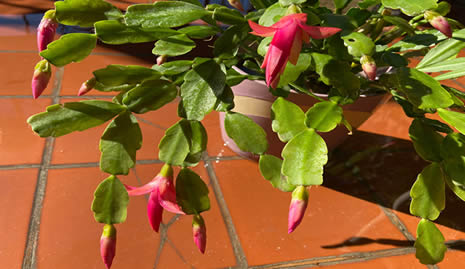
The other obvious solution might seem to be to simply increase the humidity in the room in which the christmas cactus plant is growing.
However, this is not practical for several reasons.
Firstly, it is difficult to maintain high humidity levels in just one room of your home. As people come and go, and doors open and close, the humidity levels will rise and fall and be inconsistent. Secondly, human beings do not feel comfortable in environments with high humidity.
So, increasing the overall humidity within the room where you placed your christmas cactus is not a very practical solution.
Luckily, there is a very easy way to increase humidity levels directly around the plant without having to rely on misting, water trays or an overall increase in home humidity levels.
Simply use a terracotta pot. To understand why terracotta is such an effective solution for increasing humidity read the section above titled what are the best christmas cactus pots.
Christmas Cactus Light And Water Requirements
Now that your christmas cactus has been given a good foundation for healthy growth with the correct soil, pot, temperature and humidity it’s time to look at the plant’s light and water needs.
5. Christmas cactus light requirements must be correct if you want blooms
Although the christmas cactus is a succulent, and most people immediately associate succulents with the sun-drenched desert, this does not mean this plant likes storing direct sunlight.
Christmas cactus grows best in strong indirect sunlight. Too much direct sunlight (anything over 2 hours per day) will cause the plant problems and negatively affect its ability to bloom successfully (see our guide for dealing with christmas cactus that won’t bloom).
This succulent requires about 8 hours of indirect sunlight per day but not more than 12 hours, i.e. the plant requires at least 12 of hours of darkness each night.
So, try to locate the plant in an area that gets about 8 hours of good indirect sunlight per day.
To learn more about this read our article christmas cactus light requirements which offers guidance for placing your succulent correctly.
It also offers tips for ensuring your plant gets enough light if it is situated in a low-light area and for protecting it from over-exposure to light.
6. Christmas cactus watering needs – the most essential aspect of the plant’s care!
Incorrect watering is by far the most common and most serious problem I have encounter when it comes to succulent houseplants!
It is essential you get the watering care of a christmas cactus right from the very outset or you will damage your plant and maybe even kill it.
Christmas cactus, being a succulent, requires much less water than other types of houseplant.
As a general rule, an average christmas cactus should be watered once every 3 weeks.
However, it is better to only water your individual plant when the top 2 cms of soil dries out.
By only watering your plant when you know the soil has dried out, sufficiently to warrant another watering, you will quickly learn the exact watering needs and schedule of your specific plant.
Environmental factors such as heat, dry air and the local climate can affect the watering needs of your plant.
Use the finger test to check the moisture levels of the plant or, for a more scientific and accurate measurement, use a cheap soil moisture meter which will also measure the ph and light levels.
When you water your christmas cactus it is best to water the plant from the bottom rather than from the top.
As I mentioned earlier in this article, christmas cactus does not like its leaves getting wet. So bottom watering removes the risk of soaking the foliage of the plant.
Sit the potted plant onto a few inches of water (just enough to cover the bottom of the pot up to about 1 inch) and leave it for about 20 minutes.
This is more than enough time for the roots and soil to soak up enough water for use over the next 2 – 3 weeks.
When you remove the plant from the water allow all excess water to drain away before placing it back on its tray (if using one) or relocating it to its usual spot – remember, christmas cactus should not be left sitting in water no matter how little water it is.
It is so important to get the watering routine right for a christmas cactus that I have written an entire article on the subject, Christmas Cactus Watering Guide – 9 Essential Tips, and I recommend you read that after you have finished this article.
Yes! It’s that important.
Christmas Cactus Fertilizer & Fertilization Schedule
Finally we need to address the feeding of a christmas cactus.
Although succulents require much less fertilization than other houseplants, like all plants, they still need to be fed occasionally.
Here I will outline the best type of fertilizer to use on a christmas cactus and the ideal feeding schedule you should follow.
7. Never use full strength fertilizer on christmas cactus
Christmas cactus is just like other succulents in the fact you must avoid overfeeding it.
This means that regular houseplant fertilizers are often much too nutrient-rich for succulents and they rarely have the correct ratio of nitrogen, phosphorus and potassium for christmas cactus.
Although you can dilute a regular houseplant fertilizer and use it on succulents I have rarely found this to be as effective as using a dedicated liquid succulent feed.
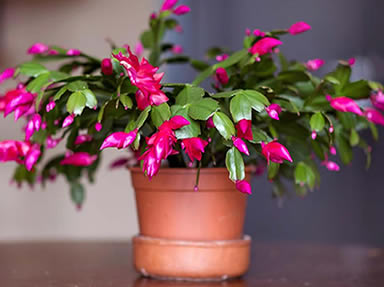
Succulent fertilizer (also known as cactus fertilizer) has just the right amount of nutrients in the correct quantities for a christmas cactus.
Using a cacti or succulent fertilizer also removes the need to dilute the strength of normal plant feed, which you would need to do with a non-succulent fertilizer.
8. How often you should fertilize your christmas cactus
Succulents not only require a lower strength fertilizer than most other houseplants but they also often require feeding less often as well.
However, with christmas cactus you can feed the plant more often (prior to blooming only) than you normally would feed other succulents.
Use a well balanced cactus or succulent fertilizer prior to the blooming of your christmas cactus.
This should be every 2 weeks from April to October, prior to blooming season, as this will increase the blooms and make them more vibrant. I use this liquid fertilizer and apply it directly to the soil without adding water as this way there is no chance of overwatering the cactus.
A tip for better and deeper much more lush foliage color, as well as more vibrant blooms, is to also add a little epsom salts to the soil once every three weeks.
Do this only when the plant is due to be watered. Thoroughly mix 1 teaspoon of epsom salts per gallon of water and water your plant from the bottom as normal.
You should stop plant feeding when the christmas cactus begins to bloom and produce flowers though you can continue to use epsom salts when you water your cactus.
Adding feed to the plant when it begins to bloom can actually cause the buds to fall off before they have had time to mature and flower.
Also refrain from using fertilizer on a christmas cactus when the plant is not actively growing after blooming is complete.
This means that on average you should not fertilize a christmas cactus from November to March.
Watering during this period should also be reduced. Ensure you only water the plant when the top later of soil has dried out.
This can often mean longer periods between watering as the plant requires less water as growth slows.
Christmas cacti plants rarely need repotting as this succulent prefers to be crowded.
Though, you may want to repot your plant in fresh soil every few years or when you want to encourage bigger growth by repotting in a larger pot.
Remember to repot in terracotta pots. Terracotta not only looks great with succulents, especially christmas cactus, but the natural composition of the material helps increase humidity levels directly around the plant inside the pot because terracotta “sweats” moisture from the soil.
Moisture in the soil naturally seeps through terracotta to form tiny water beads on the outer shell of the pot.
This moisture then evaporates into the air thus increasing humidity levels in that small area directly around the plant.
You may also be interested in our christmas cactus growing guide which walks you through the process of cultivating this beautiful succulent from seed or cutting.

